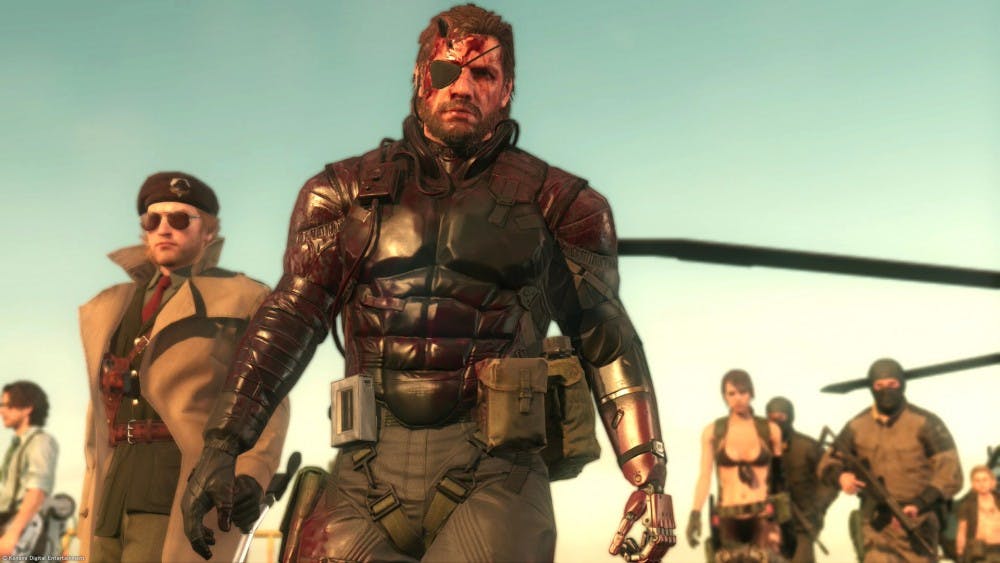This review was based off of the PC version on Steam.
It’s been seven years since a main-series Metal Gear game was released on consoles. With every side-game in-between, such as
Peace Walker and Ground Zeroes, Kojima Productions has taken the best aspects and wrapped them all into one, revenge-filled package. Kojima Production brings down the house with their swan song: Metal Gear Solid V: The Phantom Pain.
Combat and stealth
Although
Ground Zeroes gave players a general understanding of how The Phantom Pain would function, Kojima Productions made much needed changes to both the controls and how even the simplest of actions would play out. KojiPro sought to give players more control than in Ground Zeroes. Vocal commands are now initiated by clicking rather than hovering over an option, and getting into cover feels more natural rather than the – sometimes hampering – “stick to cover.” All of this ties together for a more ergonomic experience.
One of the strongest changes brought to the series is the diversification of gameplay. Due to obtuse aiming controls or poor durability, a violent approach would be considered suicide in earlier
Metal Gear titles. Thankfully, KojiPro brings to the players a streamlined, but excellent, combat system that is useful in any situation. Improved aiming allows for precision with lethal and nonlethal weapons, and the high amount of weapons to choose from and develop ensures players will never get bored by sticking to the same loadout. The addition of buddies compliments this diversity. Quiet surgically eliminates enemies from afar with precision, but requires skill to use optimally. Diamond Dog effectively replaces the famed “Soliton Radar” as he can notify the player of enemies, weapons, and other animals, serving as an excellent infiltration buddy. If the player is craving a weapon that probably won’t surpass Metal Gear but is still capable of wanton destruction, then the customizable D-Walker definitely fits that situation.
Even the core concept of infiltration is improved upon with the implementation of missions in an open-world area. Zones are no longer restricted to a binary sense of “entry point/exit point” and still allow for intuitive level design, with players still having to weave between patrol routes, enemy vehicles, and whatever else Big Boss may encounter on his quest for revenge.
Mother Base and Diamond Dogs

Any time the player is not out in the mountains of Afghanistan or anywhere else in the field, they will more than likely be in their Aerial Command Center. This is the hub for
The Phantom Pain’s base-building elements. Here players develop weapons, equipment, and manage Diamond Dog’s staff and Mother Base itself with the diegetic interface of the iDroid. The iDroid itself has many intuitive features available, with many shortcuts that allow for skillful, on-the-fly deployment of equipment while in the field. Unfortunately, operating the iDroid while online results in long load times for features that don’t even require an internet connection.
Returning from
Peace Walker the player’s main source of recruitment will be extracting enemy soldiers with the Fulton system. Once the player is close enough, an enemy can be hooked with this over-the-top balloon and sent immediately to Mother Base. This serves as an incentive to not murder absolutely everyone, as the more staff the player has, the more benefits their teams have to offer.
Within Mother Base itself,
The Phantom Pain offers many opportunities for customization. Everything from the emblem of units to the camouflage pattern of vehicles can be changed. Visiting Mother Base after missions allows for the player to see how it changes as the game progresses, but unfortunately there really isn’t all that much to do. The Phantom Pain offers a few target practice sequences and practice infiltrations of your base, but interacting with the other Diamond Dogs is limited to CQC and interrogations. Even key characters such as Kaz and Ocelot are only seen in cutscenes and under specific circumstances.
The Fox Engine
Considering how long
The Phantom Pain was in development, the wait was definitely worth it. With its impressive draw distance and lighting, the Fox Engine results in photorealistic scenes and landscapes. Exiting a building during the day results in a blinding blow-out, representing Big Boss’s eyes adjusting to the drastically different light. During sandstorms and rain, thousands of particles run across the screen in addition to whatever else the player may be doing, with no drops in the framerate. Kojima Production’s Fox Engine stamps itself as a true candidate for “next-gen” software.
Story
In this not-so-subtle Moby Dick inspired quest for revenge,
The Phantom Pain uses Peace Walker’s approach to a more episodic story. Quite literally, in fact, as every mission ends in a – – credit sequence. Without getting into spoilers, The Phantom Pain at first raises more questions than it answers. As the player progresses through the game, more and more facts are brought to light. As per Metal Gear tradition, multiple factions play off each other’s political ideologies, misinformation, and proper application and philosophy of a giant nuclear robot. Even though this is Metal Gear’s darkest story to date, dealing with child soldiers, revenge, and the start of darkness for the original Metal Gear villain, much of the series’ staple absurdity is present. Each mission can begin with Big Boss and a wolf wearing an eye-patch who was trained by a Russian cowboy flying in on a chopper blaring “The Final Countdown” by Journey, just to start. As Metal Gear Solid took influence from 1990’s action movies, and Metal Gear Solid 3: Snake Eater parodies old spy fiction, The Phantom Pain’s tone is reminiscent of 1980’s action series such as MacGuyver and The A-Team.
TL;DR
Hideo Kojima and his team at Kojima Productions present a revenge-filled but still over-the-top chapter to the story of Big Boss, as reflected in the gameplay with action being more viable. For those who love stealth,
The Phantom Pain still retains that espionage action at the heart of the Metal Gear series.
Synopsis
+ Varied gameplay
+ Gorgeous graphics and superb optimization
+ The
Metal Gear absurdity fans know and love
- Lack of interactivity in Mother Base itself
- Slow load times in Online mode
Bonus puppy







